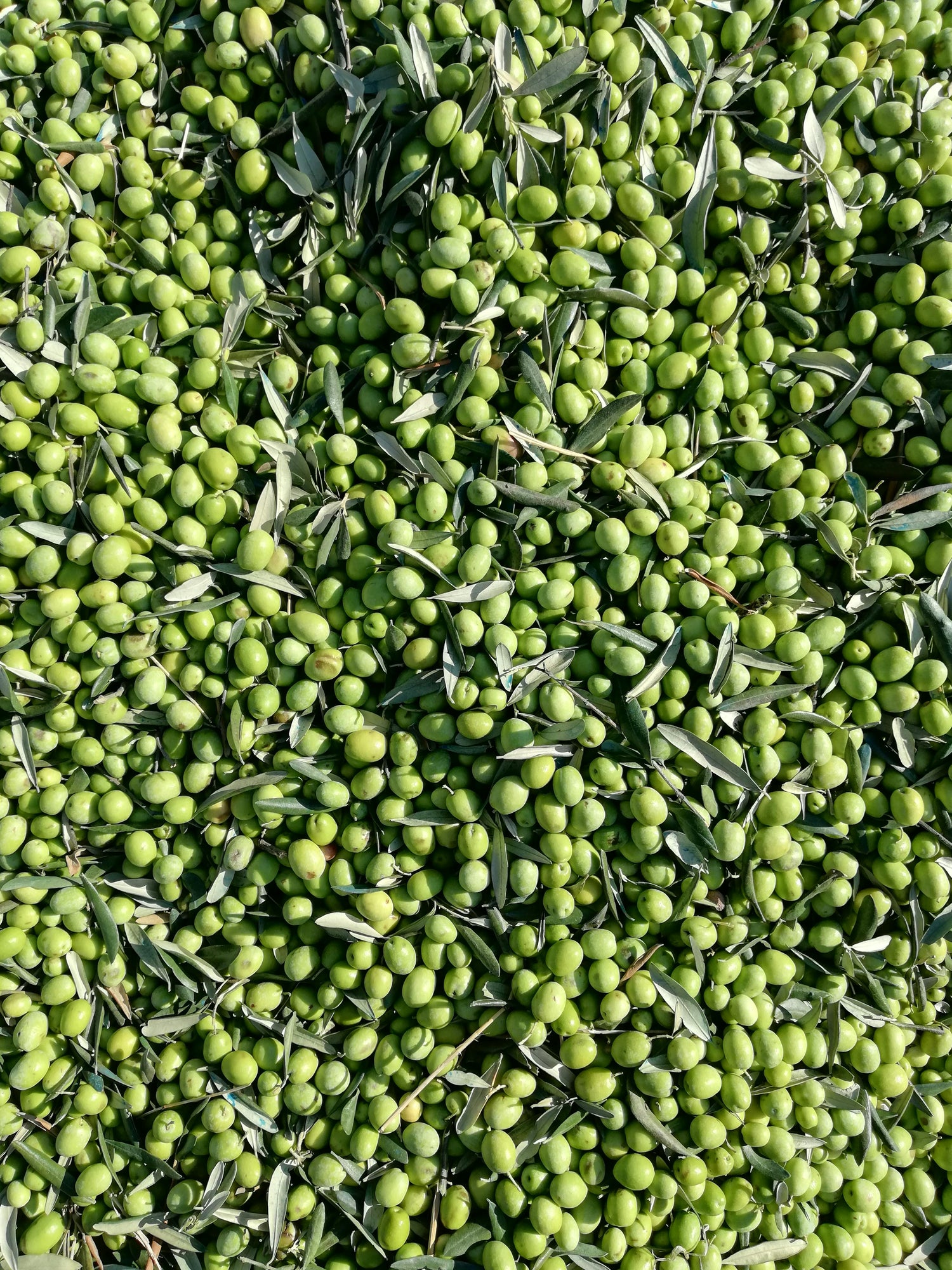-
Biancolilla di Caltabellotta
It is considered one of the oldest varieties among those currently found in Sicilian olive groves.
Organoleptic Characteristics:
The extra virgin olive oil from Biancolilla is highly prized. It has a greenish-yellow to straw-colored hue with slightly golden highlights. This oil is characterized by a light fruitiness, slightly peppery, and very aromatic, with noticeable fragrances of almond, tomato, and artichoke, complemented by flavors of fresh grass and green olive. -
Nocellara del Belice:
It represents a highly prized cultivar and is probably one of the most esteemed among the Sicilian native varieties. Present in the Sicilian territory for several centuries (likely since the times of Magna Graecia), this cultivar is excellent both for the production of extra virgin olive oil and for table consumption.
Organoleptic characteristics:
The oil obtained from the pressing of these olives generally has a coloration that can range from yellow to deep green and very low acidity. On the nose, the oil presents a medium intensity olive fruitiness accompanied by notes of almond, green tomato, cut grass, artichoke, and sometimes aromatic herbs. The taste is bitter, slightly pungent, with a hint of sweetness.In cooking, this oil excels both raw (for seasoning soups, vegetables, and salads) and cooked (in the preparation of roasts and fried dishes, both meat and fish) thanks to its higher smoke point compared to other types of oils. The polyphenol content is high.
-
Nocellara Messinese:
It is a native cultivar and is used both for the production of extra virgin olive oil and for table consumption.
Organoleptic characteristics:
The extra virgin olive oil obtained has a yellow color mixed with green and presents on the nose as a fruitiness of not too high intensity, usually associated with sensations of almond, cut grass, tomato, artichoke, and aromatic herbs. The taste is characterized by the presence of spiciness, while the sweet and bitter sensations are less pronounced but still present.The high content of tocopherols and monounsaturated fats, which are highly digestible, makes this oil an excellent ingredient for those seeking dishes with a high amount of antioxidants and for those following low-cholesterol diets. The low acidity ensures that the extra virgin olive oil sold online has a higher smoke point compared to other oils, making it ideal for frying both meat and fish. Nonetheless, it also adapts excellently for seasoning raw foods, vegetables, and salads.
-
Nocellara Etnea:
It is a native cultivar.
Organoleptic Characteristics:
The oil is characterized primarily by a very low level of acidity. On the nose, it features a fruitiness with sensations of green tomato, leaf grass, almond, and occasionally thistle and artichoke. The fruitiness ranges from medium to high intensity. On the palate and in the aftertaste, this oil is quite pungent and somewhat bitter, while the sweetness increases if the oil is obtained from fully ripe olives. It is rich in polyphenols, thus possessing excellent antioxidant properties. -
TONDA IBLEA
As the name suggests, it is a native Sicilian cultivar. Its ideal habitat is in hilly areas up to about 600 meters above sea level, making it highly resistant to cold temperatures.
Organoleptic Characteristics:
This oil has a combination of typically Sicilian flavors. It is marked by an intense olive fruitiness, accompanied by a varied bouquet of scents such as tomato, almond, artichoke, cut grass, and aromatic herbs. The taste is very harmonious, predominantly featuring sweet and spicy notes, while the bitterness is very mild. The color is green-gold, and the overall acidity is very low. In contrast, it is rich in polyphenols and vitamin E. -
GIARRAFFA
Among the dual-purpose cultivars (those suitable both for the production of extra virgin olive oil and for table consumption), the Giarraffa olive variety is undoubtedly one of the most well-known and appreciated. This variety has very ancient origins, potentially dating back to the times of the Sicani and Elymi, populations that inhabited Sicily several centuries before Christ.
Organoleptic Characteristics:
The extra virgin olive oil obtained from Giarraffa olives typically produces a light fruitiness with sensations of almond, artichoke, and tomato leaf. The taste is sweet, with a slight presence of spiciness and bitterness, the latter especially noticeable in the aftertaste. Nutritionally, it is rich in antioxidant substances.
-
Minutidda:
It is a very rare olive cultivar, known only to great enthusiasts and connoisseurs of extra virgin olive oil, and is native to Sicilian olive groves.
Organoleptic Characteristics:
The oil obtained from the pressing of these olives presents a light fruitiness on the nose, with hints of ripe fruit, particularly pear, banana, and custard apple. Additionally, there are sensations of freshly picked almond, artichoke, cut grass, and green tomato. On the palate, this oil is slightly pungent and bitter, but in a mild and not too pronounced manner. The flavor is fluid and moderately persistent. The color of the Murtiddara cultivar oil tends towards green. The presence of polyphenols in the monovarietal extra virgin olive oil makes this variety highly recommended for those seeking a healthy diet rich in antioxidants and anti-aging properties.In the kitchen, the oil obtained from pressing these olives is very suitable for daily use due to its low acidity, and for seasoning salads and dishes based on meat and fish.


